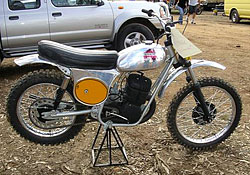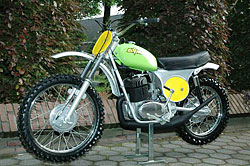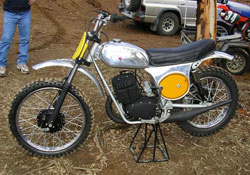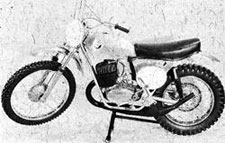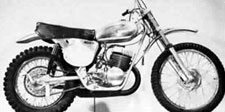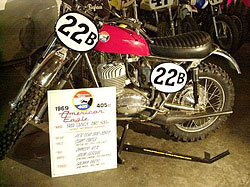|
||||||||||||||||
The press tried to be fair, commenting at length about the fine handling and shiny finish but in the end had to tell the sorry truth about the disastrous 405 engine and its lack of competitive performance and weird transmission. They were far more enthusiastic about the OSSA powered Alrons however. The Phantom 250 powered bike was actually quite a reasonable motocross weapon and the Pioneer powered enduro model was well received by the enduro fraternity but why buy the less developed Alron 250 when you could buy a genuine OSSA Phantom or a competition proven ISDT Replica much cheaper? Like the press, potential Alron dealers also tended to sit on the fence, secure in their Japanese and European franchises and unprepared to gamble on an untested homegrown product. Approximately forty OSSA powered 250s and twenty or so of the ill fated 405 Sprite powered bikes were sold before the Lyon brothers folded the Alron part of their company after a couple of years. BELGIUM: At the same time in Belgium, businessmen Jan Boonen and Jaques Van Velthoven started producing the BVM, in an attempt to create a homegrown motocross bike in the spiritual home of motocross. Belgium hadn’t produced a serious motocross bike of their own since the legendary F.N. machines of Rene Baeten back in the fifties. The initial plan was to produce sixty to eighty bikes in the first year fitted with a Sprite 405 engine and a British sourced chrome moly frame (starting to sound familiar?) REH hubs, Motoplat ignition and their ‘own designed’ Aluminium tank. Not surprisingly the bike was poorly received in Belgium and production ceased well short of the intended production numbers. The restored bike shown below is on display in bullet proof display case* at the owners home in Lommel, Belgium. *(One could cruelly speculate that the bullet proof case is an attempt to prevent disgruntled former BVM investors from shooting the crap out of the bike!) Belgium and Australia are two countries that are not particularly known for their motocross bike production, the Alron and BVM being rare exceptions. Sadly, it’s my duty as a purveyor of truth and justice to report that both of these bikes had absolutely no local input into their production whatsoever. The Alron and BVM are exactly the same motorcycle built by Frank Hipkin’s Sprite Developments in England. The only Belgian or Aussie input was presumably to hire a couple of guys to assemble the kit bikes and apply the tank stickers after their arrival from the UK. For over thirty years the Australian public have believed that the Alron was an all Aussie enterprise, a failed one sure, but Aussie just the same. I presume the Belgians were also sold the same story about their “all Belgian BVM”. COMPARE THE ABSOLUTELY IDENTICAL BVM AND ALRON BELOW:
UNITED STATES:
Although the photos aren’t the best quality, even Stevie Wonder could see the Sprite/Alron/BVM family traits. This great tale of ‘badge engineering’ isn’t limited to motorcycle manufacturing backwaters like Australia or Belgium either. Have you ever heard of the AMERICAN EAGLE 405? Yep, it’s another member of this ever growing little club. The bikes were initially imported to the US by a company called the American Eagle Corporation. They must have sold reasonably well because they appear to have hung in there from 1969 to at least 1972, importing an unknown number of bikes until they suddenly went bankrupt holding many unpaid for bikes in warehouse stock. The stock was eventually auctioned and purchased by McCormack International who heavily discounted the bikes as well as selling them by mail order and through department stores. The final model offered is almost identical to the BVM/Alron versions. One interesting difference to other Sprite clones are the outer engine cases of the Sprite engine being cast with the American Eagle logo. This helped perpetuate the assumption that the American Eagle was an American product. Although the importers didn’t actually lie about the origin of the bike, they also didn’t exactly shout from the rooftops that they were made in England. The advertisement below gives all of the vital statistics except its place of manufacture. You still occasionally see a ‘brand new, never ridden’ American Eagles on eBay going for not unreasonable money.
Here is the notation from Wikpedia: The English Sprite, a 405cc motocross bike, was sold in the U.S. as American Eagle.
Below: Rick ‘Super Hunky’ Siemans take on the American Eagle from his column in Off-Road.com.
GREAT BRITAIN: Wikpedia extract: Sprite was an English manufacturer of trials and motocross (scrambles) machines that were mostly available in kit-form. They were built with 123-, 244-, and 405-cc two-stroke engine In mid 1964 Frank Hipkin, a British racer of considerable talent, started building lightweight motocross frames for his own use. Before long fellow racers, eager for something lightweight to replace the agricultural gear they had been forced to ride, had inundated him with orders for his well designed frames for themselves. Sprite Developments was born. From the start Sprite frame kits for Villiers and Triumph Cub engines were extremely successful. They were neat, well constructed in lightweight Reynolds tubing and most importantly, extremely cheap. Hipkin, with a business sense more than equal to his engineering prowess was able to exploit a legal loophole in the British tax system by selling his products in kit form much cheaper than the opposition. Sprites sold very well, often as just as a frame kit into which the customer could fit whatever engine he chose along with their own wheels and suspension components. This then revolutionary idea enabled racers to update their heavy and obsolete motocross bikes for a tiny percentage of the cost of a complete new bike.
Hipkins early complete kit bikes featuring iron barreled 250 Villiers engines along with Sprites own Earles type forks sold for a bargain price of 154 pounds, a bargain even in the depressed financial markets of the mid sixties. Within a short time Hipkin was producing blatant copies of Ceriani forks as an option and offering them and the new all alloy Villiers Starmaker engine. Production grew from a handful of bikes per week to hundreds, most destined for export. This explosion in sales was unfortunately to be the start of the company’s gradual downfall. Naturally enough, other companies had taken note of the Sprite success and before long unassembled complete bikes or simple frame kits were being marketed by a growing number of companies. The British Government, concerned at the loss of tax revenue closed the loophole that Hipkin had exploited so cleverly. Nevertheless, Sprite sales continued gaining momentum. Kits for both Husqvarna and Maico engines followed in the wake of the collapse of the Villiers company and then in 1968, Hipkin announced the release of Sprites own engine, a not too well disguised copy of Husqvarnas 360cc engine bored out to 405cc. Together with an upgraded frame and Sprites Ceriani copy forks, REH hubs and other quality parts, the complete kits were exported all over the world and marketed as whatever the importer wished to call them. Unfortunately a huge order to the American Eagle Corporation directly led to Sprites demise. The American company went bankrupt after delivery of the 405 scramblers had been made which was too much of a financial loss for Sprite Developments to absorb. The company never recovered and soon stopped motorcycle production. The company still exists today but has no ties to the motorcycle industry. *** |
|
|||||||||||||||
|
||||||||||||||||



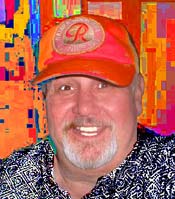 This month, I thought I’d relate one of the stranger stories in our sports history. It’s a tale of shady characters, dubious engineering and less than honest marketing that when combined make the basis for a great little yarn that I call:
This month, I thought I’d relate one of the stranger stories in our sports history. It’s a tale of shady characters, dubious engineering and less than honest marketing that when combined make the basis for a great little yarn that I call: